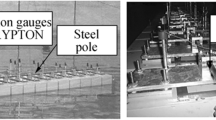Abstract
In this paper, a modified smoothed particle hydrodynamics (SPH) formula is deduced to solve the problem of interfaces with a high density ratio. Simplified SPH models for single and double cylindrical shells (abbreviated as single-hull and double-hull models, respectively) are established to study shock wave propagation and to conduct the damage analysis. The SPH results for the single-hull model are verified by AUTODYN. In addition, the damage analysis indicates that the single-hull model is damaged more severely than the double-hull model. The inner shell in the double-hull model is protected by a water interlayer.
Similar content being viewed by others
References
A. M. Zhang, L. Y. Zeng, X. D. Cheng, et al., “The Evaluation Method of Total Damage to Ship in Underwater Explosion,” Appl. Ocean Res. 33 (4), 240–251 (2011).
V. S. Deshpande and N. A. Fleck, “One-Dimensional Response of Sandwich Plates to Underwater Shock Loading,” J. Mech. Phys. Solids 53 (11), 2347–2383 (2005).
Y. Wang, W. Zhang, H. X. Hua, et al., “Dynamic Response of a Submarine Foam Sandwich Structure Subjected to under Water Explosion.” J. Vibr. Shock 29 (4), 64–68 (2010) [in Chinese].
A. M. Zhang, W. X. Zhou, S. P. Wang, et al., “Dynamic Response of the Non-Contact Underwater Explosion on Naval Equipment,” Marine Struct. 24 (4), 396–411 (2011).
U. M. Hans, “Review: Hydrocodes for Structure Response to Underwater Explosion,” Shock Vibr. 6 (2), 81–96 (1999).
J. W. Swegle and S. W. Attaway, “On the Feasibility of Using Smoothed Particle Hydrodynamics for Underwater Explosion Calculations,” Comput. Mech. 17 (3), 151–168 (1995).
A. M. Zhang, S. P. Wang, C. Huang, et al., “Influences of Initial and Boundary Conditions on Underwater Explosion Bubble Dynamics,” Eur. J. Mech., B: Fluid 42, 69–91 (2013).
A. H. Keil, Introduction to Underwater Explosion Research (UERD, Norfolk Naval Ship Yard, Portsmouth, 1956).
A. H. Keil, “The Response of Ships to Underwater Explosions,” Trans. Soc. Naval Arch. Marine Eng. 69, 366–410 (1961).
R. Rajendran and K. Narasimhan, “Damage Prediction of Clamped Circular Plates Subjected to Contact Underwater Explosion,” Int. J. Impact Eng. 25 (4), 373–386 (2001).
G. N. Nurick and A. M. Radford, “Deformation and Tearing of Clamped Circular Plates Subjected to Localized Central Blast Loads,” in Recent Developments in Computational and Applied Mechanics: A Volume in Honour of John B. Martin (International Centre for Numerical Methods in Engineering (CIMNE) (Barcelona, Spain, 1997).
R. Q. Liu, X. F. Bai, and X. Zhu, “Breach Experiment Research of Vessel Element Structure Models Subjected to Underwater Contact Explosion,” J. Naval Univ. Eng. 13 (5), 41–46 (2001) [in Chinese].
Y. W. Lee and T. Wierzbicki, “Fracture Prediction of Thin Plates under Localized Impulsive Loading. Part I: Dishing,” Int. J. Impact Eng. 31 (10), 1253–1276 (2005).
Y. W. Lee and T. Wierzbicki, “Fracture Prediction of Thin Plates under Localized Impulsive Loading. Part II: Discing and Petaling,” Int. J. Impact Eng. 31 (10), 1277–1308 (2005).
J. H. Kim and H. C. Shin, “Application of the ALE Technique for Underwater Explosion Analysis of a Submarine Liquefied Oxygen Tank,” Ocean Eng. 35 (8/9), 812–822 (2008).
M. B. Liu, G. R. Liu, Z. Zong, and K. Y. Lam, “Computer Simulation of High Explosive Explosion using Smoothed Particle Hydrodynamics Methodology,” Comput. Fluids 32 (3), 305–322 (2003).
A. M. Zhang, W. S. Yang, and X. L. Yao, “Numerical Simulation of Underwater Contact Explosion,” Appl. Ocean Res. 34, 10–20 (2012).
A. M. Zhang, W. S. Yang, C. Huang, and F. R. Ming, “Numerical Simulation of Column Charge Underwater Explosion Based on SPH and BEM Combination,” Comput. Fluids 1, 169–178 (2013).
A. M. Zhang, F. R. Ming, and S. P. Wang, “Coupled SPHS-BEM Method for Transient Fluid-Structure Interaction and Applications in Underwater Impacts,” Appl. Ocean Res. 43, 223–233 (2013).
F. R. Ming, A. M. Zhang, W. S. Yang, et al., “SPH Algorithm to Deal with the Problem of Underwater Contact Explosion of Warship,” J. Vibr. Shock 31 (10), 147–151 (2011) [in Chinese].
G. R. Liu and M. B. Liu, Smoothed Particle Hydrodynamics—A Meshfree Particle Method (World Sci., Singapore, 2003).
B. M. Dobratz, LLNL Explosives Handbook: Properties of Chemical Explosives and Explosives and Explosive Simulants (Lawrence Livermore Nat. Lab., Livermore, 1981); http://www.osti.gov/scitech/biblio/6530310.
D. J. Steinberg, Spherical Explosions and the Equation of State of Water (Lawrence Livermore Nat. Lab., Livermore, 1987); http://www.osti.gov/scitech/biblio/6766676.
L. D. Libersky, A. G. Petscheck, T. C. Carney, et al., “High Strain Lagrangian Hydrodynamics a Three- Dimensional SPH Code for Dynamic Material Response,” J. Comput. Phys. 109 (1), 67–75 (1993).
G. R. Johnson and W. H. Cook, “A Constitutive Model and Data for Metals Subjected to Large Strains, High Strain Rates and High Temperatures,” in Proc. 7th Int. Symp. on Ballistics, USA, 1983.
R. V. Mises, “Mechanik der Festen Körper im Plastisch Deformablen Zustand,” in Nachrichten von der Gesellschaft der Wissenschaften zu Göttingen (Math.- Phys. Klasse, 1913), pp. 582–592.
S. Z. Zhang, Explosion and Shock Dynamics (Weapon Industry Press, Beijing, China, 1993) [in Chinese].
B. V. Zamyshlyayev, Dynamic Loads in Underwater Explosion (Naval Intelligince Support Center, Washington, 1973). AD-757183.
G. T. Yang, Introduction to Elasticity and Plasticity (Tsinghua Univ. Press, Beijing, China, 2004) [in Chinese].
J. B. Gai, S. Wang, and P. Tang, “Damage of Thin Plate Subjected to Contact Explosion Loading,” J. Harbin Eng. Univ. 27 (4), 523–525 (2006) [in Chinese].
Author information
Authors and Affiliations
Corresponding author
Additional information
Original Russian Text © Z. Zhang, L. Sun, X. Yao, X. Cao.
Published in Fizika Goreniya i Vzryva, Vol. 51, No. 4, pp. 116–125, July–August, 2015.
Rights and permissions
About this article
Cite this article
Zhang, Z., Sun, L., Yao, X. et al. Smoothed particle hydrodynamics simulation of the submarine structure subjected to a contact underwater explosion. Combust Explos Shock Waves 51, 502–510 (2015). https://doi.org/10.1134/S0010508215040164
Received:
Accepted:
Published:
Issue Date:
DOI: https://doi.org/10.1134/S0010508215040164




